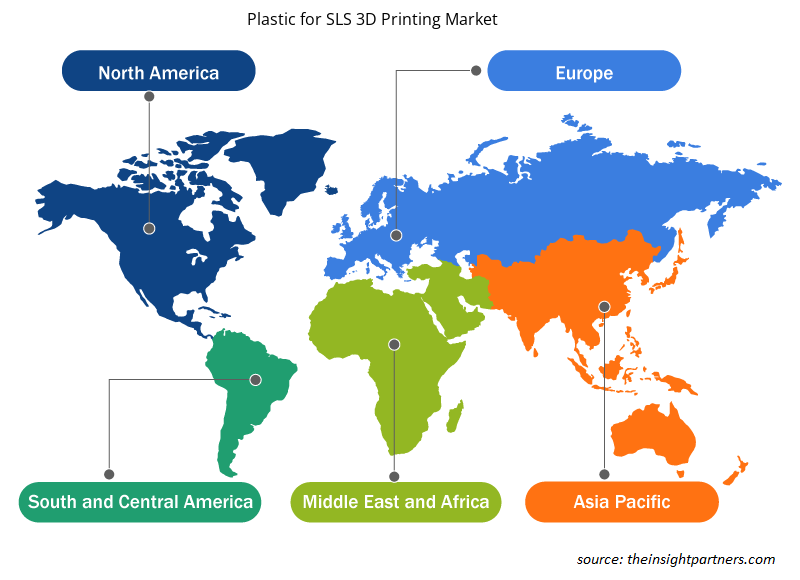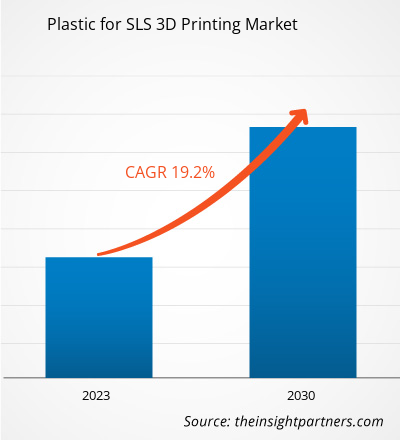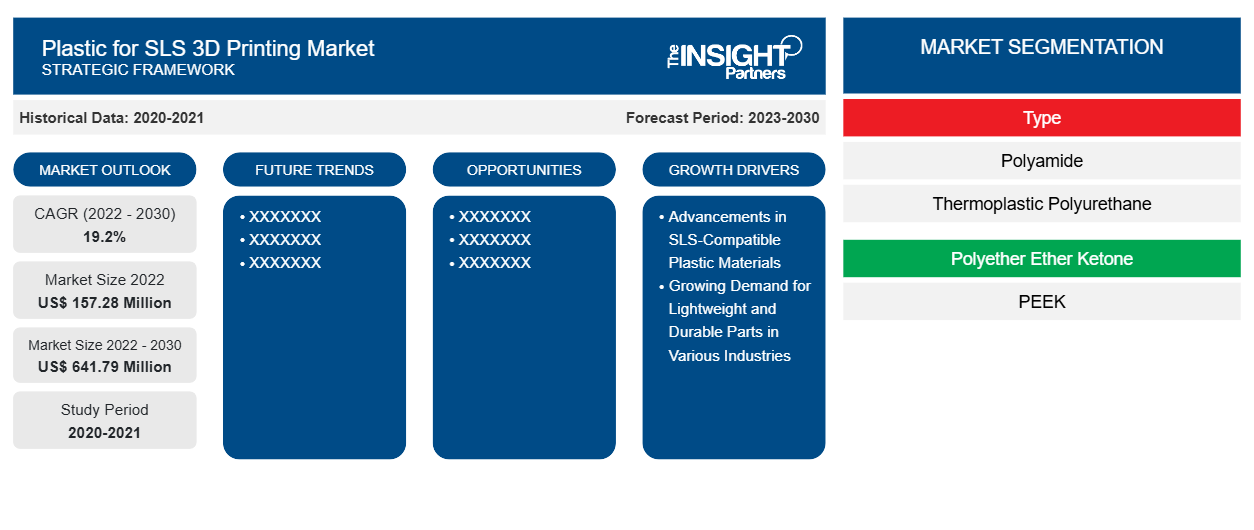[연구보고서] SLS 3D 프린팅용 플라스틱 시장 규모는 2022년에 1억 5,728만 달러로 평가되었으며, 2030년까지 6억 4,179만 달러에 도달할 것으로 예상되며, 2022년부터 2030년까지 연평균 성장률 19.2%를 기록할 것으로 예상됩니다.
시장 분석
선택적 레이저 소결(SLS)은 고출력 레이저를 사용하여 3D 모델을 기반으로 폴리머 파우더를 고체 구조로 소결하는 적층 제조 기술입니다. SLS 3D 프린팅은 엔지니어와 제조업체에게 인기 있는 선택입니다. SLS 3D 프린팅에 가장 일반적으로 사용되는 소재는 나일론입니다. 나일론은 기능성 프로토타입 제작 및 최종 사용 생산을 위한 매우 유능한 엔지니어링 열가소성 수지입니다. 또한 복잡한 조립품과 높은 환경 안정성을 갖춘 내구성 있는 부품에도 이상적입니다. SLS 3D 프린팅은 엔지니어링, 제조, 의료 등 광범위한 산업에서 널리 사용됩니다. SLS 3D 프린팅 시장에서 플라스틱 성장을 주도하는 주요 요인은 SLS 호환 플라스틱 소재의 발전과 다양한 산업에서 가볍고 내구성 있는 부품에 대한 수요가 증가하고 있기 때문입니다.
성장 동인 및 과제
SLS 호환 플라스틱 소재의 발전과 다양한 산업에서 가볍고 내구성 있는 부품에 대한 수요 증가는 글로벌 플라스틱 SLS 3D 프린팅 시장 성장을 촉진하는 몇 가지 요인입니다. 많은 회사가 내구성, 내열성, 유연성과 같은 개선된 특성을 가진 SLS 호환 플라스틱 소재의 지속적인 개발에 집중하고 있습니다. 예를 들어, HP와 BASF와 같은 회사는 혁신적인 SLS 소재를 개발하기 위해 협력해 왔습니다. 연료 효율을 개선하기 위해 무게를 줄이는 것이 가장 중요한 관심사인 항공우주 분야에서 SLS로 생산된 플라스틱 구성 요소가 인기를 얻고 있습니다. 예를 들어, Airbus는 강도나 안전성을 손상시키지 않으면서 무게를 줄이는 데 기여하는 브래킷 및 덕팅 구성 요소를 포함하여 SLS 3D 프린팅 플라스틱 부품을 A350 XWB 항공기에 통합했습니다. 자동차 산업도 SLS 플라스틱 부품을 받아들였습니다. 따라서 다양한 산업에서 경량 플라스틱 부품에 대한 수요가 크게 증가함에 따라 SLS 3D 프린팅용 플라스틱에 대한 필요성이 높아지고 시장 성장이 촉진되고 있습니다.
고품질 SLS 호환 플라스틱 소재의 비용은 이 기술 도입을 고려하는 비용 의식이 강한 기업에 장애물로 작용할 수 있습니다. SLS는 강도와 내구성이 있는 복잡한 부품을 생산할 수 있는 능력을 포함하여 수많은 이점을 제공하지만, 소재의 가격은 의사 결정 과정에서 중요한 요소가 될 수 있습니다. 따라서 SLS 호환 플라스틱의 높은 비용은 다양한 응용 분야에서의 사용을 제한하여 SLS 3D 인쇄용 플라스틱 시장 성장을 방해합니다.
귀하의 요구 사항에 맞게 이 보고서를 사용자 정의하세요
이 보고서의 일부 또는 국가 수준 분석, Excel 데이터 팩을 포함하여 모든 보고서에 대한 사용자 정의를 무료로 받을 수 있으며 신생 기업 및 대학을 위한 훌륭한 혜택과 할인 혜택을 이용할 수 있습니다.
-
이 보고서의 주요 시장 동향을 알아보세요.이 무료 샘플에는 시장 동향부터 추정 및 예측까지 다양한 데이터 분석이 포함됩니다.
보고서 세분화 및 범위
"글로벌 SLS 인쇄용 플라스틱 시장 분석 및 2030년 예측"은 글로벌 시장 동향과 성장 기회에 중점을 둔 전문적이고 심층적인 연구입니다. 이 보고서는 유형, 최종 사용 산업 및 지리적 위치에 따라 자세한 시장 세분화를 통해 글로벌 시장에 대한 개요를 제공하는 것을 목표로 합니다. 이 보고서는 주요 지역 및 국가에서의 수요와 함께 전 세계 SLS 3D 인쇄용 플라스틱 소비에 대한 주요 통계를 제공합니다. 또한 이 보고서는 주요 지역 및 국가에서 SLS 3D 인쇄용 플라스틱 시장 성과에 영향을 미치는 다양한 요인에 대한 정성적 평가를 제공합니다. 또한 SLS 3D 인쇄용 플라스틱 시장의 선도적 기업과 주요 전략적 개발에 대한 포괄적인 분석도 포함되어 있습니다. 시장 역학에 대한 분석도 포함되어 주요 원동력 요인, 시장 동향 및 수익성 있는 기회를 파악하는 데 도움이 되며, 이는 차례로 주요 수익 주머니를 파악하는 데 도움이 됩니다.
생태계 분석과 포터의 5가지 힘 분석은 글로벌 SLS 3D 프린팅용 플라스틱 시장에 대한 다각적인 관점을 제공하여 전체 공급망과 시장 성장에 영향을 미치는 다양한 요소를 이해하는 데 도움이 됩니다.
세그먼트 분석
SLS 3D 프린팅용 글로벌 플라스틱 시장은 유형과 최종 사용 산업을 기준으로 구분됩니다. 유형에 따라 SLS 3D 프린팅용 플라스틱 시장은 폴리아미드 , 열가소성 폴리우레탄(TPU) , 폴리에테르 에테르 케톤(PEEK) 등으로 구분됩니다. 폴리아미드 세그먼트는 2022년 SLS 3D 프린팅용 플라스틱 시장에서 상당한 점유율을 차지했습니다. 폴리아미드는 뛰어난 품질과 적응성으로 인해 SLS 3D 프린팅에 선호되는 소재입니다. SLS에 사용되는 다양한 유형의 폴리아미드 중에서 폴리아미드 12(PA12)가 특히 인기가 있습니다. 강도, 유연성, 화학 물질 및 내열성으로 주로 사용되어 광범위한 응용 분야에 이상적인 선택입니다. 열가소성 폴리우레탄(TPU)은 SLS 3D 프린팅 시장에서 다재다능하고 점점 더 인기를 얻고 있는 소재입니다. TPU는 유연성, 내구성 및 회복성의 놀라운 균형을 보이는 엘라스토머 유형으로 광범위한 응용 분야에 적합합니다. SLS 3D 프린팅 시장에서 PEEK는 다른 열가소성 플라스틱과 구별되는 고유한 특성을 제공합니다.
최종 사용 산업 측면에서 시장은 의료, 항공우주 및 방위, 자동차, 전자 및 기타로 세분화됩니다. 또한 전자 부문은 2022년 SLS 3D 프린팅용 플라스틱 시장에서 상당한 점유율을 차지했습니다. SLS 3D 프린팅 기술은 복잡하고 맞춤형이며 소규모 전자 부품을 생산하는 데 여러 가지 이점을 제공합니다. 플라스틱 기반 SLS 3D 프린팅은 주로 가전제품용 맞춤형 인클로저 및 케이스 제조에 사용됩니다. 자동차 부문에서 SLS 3D 프린팅에 플라스틱을 사용하는 주요 이점은 업계의 엄격한 성능 및 안전 표준을 충족하는 복잡하고 가벼운 부품을 생산할 수 있다는 것입니다. 플라스틱 소재는 의료 부문에서 빠르게 성장하는 SLS 3D 프린팅 분야에서 중요한 역할을 합니다. 이러한 다재다능한 폴리머는 생체 적합성, 사용자 정의 용이성 및 비용 효율성으로 인해 다양한 응용 분야에 광범위하게 사용되고 있습니다.
지역 분석
이 보고서는 북미, 유럽, 아시아 태평양(APAC), 중동 및 아프리카(MEA), 남미 및 중미의 5개 주요 지역과 관련하여 SLS 3D 인쇄용 플라스틱 시장에 대한 자세한 개요를 제공합니다. 유럽은 SLS 3D 인쇄용 플라스틱 시장에서 상당한 점유율을 차지했으며 2022년에는 5,500만 달러 이상으로 평가되었습니다. 유럽의 자동차 산업은 연료 효율성과 성능을 개선하기 위해 차량 무게를 줄이는 방법을 끊임없이 모색하고 있습니다. 또한 이 지역의 성장하는 자동차 산업은 SLS 3D 인쇄용 플라스틱에 대한 수요를 견인할 것으로 예상됩니다. 아시아 태평양 SLS 3D 인쇄용 플라스틱 시장은 2030년까지 1억 1,000만 달러 이상에 도달할 것으로 예상됩니다. 아시아 태평양은 중국, 일본, 한국과 같은 세계에서 가장 큰 제조 경제권이 있는 곳입니다. 이러한 국가는 SLS 3D 인쇄와 같은 첨단 제조 기술에 많은 투자를 하고 있습니다. 이 지역에는 또한 적층 제조 및 SLS 3D 프린팅 회사가 있으며, 이는 예측 기간 동안 SLS 3D 프린팅용 플라스틱 시장의 성장을 더욱 촉진할 것으로 예상됩니다. 북미 SLS 3D 프린팅용 플라스틱 시장은 2022년부터 2030년까지 약 18%의 CAGR을 기록할 것으로 예상됩니다. 이 지역에 SLS 3D 프린팅 회사가 있으면 SLS 3D 프린팅용 플라스틱에 대한 수요가 더욱 촉진될 것으로 예상됩니다. SLS 3D 프린팅 회사는 최종 사용 산업의 증가하는 수요에 부응하기 위해 사업 확장을 전략화하고 있습니다. 이 지역의 자동차 및 항공우주 산업의 성장은 향후 몇 년 동안 SLS 3D 프린팅용 플라스틱 시장에 수익성 있는 기회를 창출할 것으로 예상됩니다.
산업 발전 및 미래 기회
SLS용 플라스틱 3D 프린팅 시장에서 활동하는 주요 업체가 취한 다양한 이니셔티브는 아래와 같습니다.
- 2023년 6월, 3D Systems는 일본에서 대형 펠릿 압출 3D 프린팅 도입을 촉진하기 위해 SWANY Co Ltd와 협력한다고 발표했습니다.
- 2021년 2월, 3D Systems는 Jabil Inc.와 협력하여 고속 퓨전 산업용 3D 프린터 플랫폼과 소재 포트폴리오를 출시했습니다.
- 에보닉은 2022년 10월 CO2 배출량이 훨씬 낮은 PA12 파우더를 출시하여 INFINAM 폴리아미드 12(PA12) 파우더를 정렬하여 전반적인 생태적 균형을 개선하고자 했습니다.
SLS 3D 프린팅 시장 지역별 통찰력을 위한 플라스틱
Insight Partners의 분석가들은 예측 기간 동안 SLS 3D 인쇄용 플라스틱 시장에 영향을 미치는 지역적 추세와 요인을 철저히 설명했습니다. 이 섹션에서는 북미, 유럽, 아시아 태평양, 중동 및 아프리카, 남미 및 중미의 SLS 3D 인쇄용 플라스틱 시장 세그먼트와 지리에 대해서도 설명합니다.

- SLS 3D 프린팅 시장을 위한 플라스틱에 대한 지역별 데이터 얻기
SLS 3D 프린팅 시장 보고서 범위용 플라스틱
| 보고서 속성 | 세부 |
|---|---|
| 2022년 시장 규모 | 1억 5,728만 달러 |
| 2030년까지 시장 규모 | 6억 4,179만 달러 |
| 글로벌 CAGR (2022-2030) | 19.2% |
| 역사적 데이터 | 2020-2021 |
| 예측 기간 | 2023-2030 |
| 다루는 세그먼트 |
유형별로
|
| 포함된 지역 및 국가 |
북아메리카
|
| 시장 선도 기업 및 주요 회사 프로필 |
|
시장 참여자 밀도: 비즈니스 역학에 미치는 영향 이해
SLS 3D 프린팅용 플라스틱 시장은 소비자 선호도의 변화, 기술 발전, 제품의 이점에 대한 인식 증가와 같은 요인으로 인해 최종 사용자 수요가 증가함에 따라 빠르게 성장하고 있습니다. 수요가 증가함에 따라 기업은 제품을 확장하고, 소비자의 요구를 충족하기 위해 혁신하고, 새로운 트렌드를 활용하여 시장 성장을 더욱 촉진하고 있습니다.
시장 참여자 밀도는 특정 시장이나 산업 내에서 운영되는 회사나 기업의 분포를 말합니다. 주어진 시장 공간에 얼마나 많은 경쟁자(시장 참여자)가 존재하는지 그 규모나 전체 시장 가치에 비해 나타냅니다.
SLS 3D 프린팅용 플라스틱 시장에서 활동하는 주요 회사는 다음과 같습니다.
- 3D 시스템 주식회사
- 바스프 SE
- 에보닉 인더스트리 AG
- 아르케마 SA
- 엔싱거 GmbH
면책 조항 : 위에 나열된 회사는 어떤 특별한 순서에 따라 순위가 매겨지지 않았습니다.

- SLS 3D 프린팅 시장 주요 주요 업체 개요를 알아보세요
COVID-19 팬데믹의 영향/지정학적 시나리오의 영향/경기 침체의 영향
COVID-19 팬데믹 이전에 전 세계 많은 국가가 경제 성장을 보고했습니다. 주요 제조업체는 SLS 3D 프린팅용 플라스틱의 연구 개발에 투자했습니다. 또한 광범위한 고객 기반을 충족하기 위해 합병 및 인수 전략을 통해 지리적 도달 범위를 확장하는 데 중점을 두었습니다. 팬데믹 동안 공급망 중단, 원자재 및 노동력 부족, 운영상의 어려움으로 인해 수요와 공급 격차가 발생하여 SLS 3D 프린팅용 플라스틱 시장 성장에 부정적인 영향을 미쳤습니다. 제조업체는 공급업체로부터 원자재와 성분을 조달하는 데 어려움을 겪고 있다고 보고하여 SLS 3D 프린팅용 플라스틱의 생산 속도에 영향을 미쳤습니다. 또한 공급망의 심각한 중단과 숙련 노동자의 부족으로 인한 생산 부족으로 인해 많은 지역, 특히 아시아 태평양, 유럽 및 북미에서 수요-공급 격차가 발생했습니다. 수요와 공급 격차는 자동차 산업의 수요 변동으로 인해 앞서 언급한 지역에서도 기록되었습니다.
SLS 3D 프린팅용 플라스틱 판매는 3D 프린팅 서비스 재개로 증가했습니다. SLS 3D 프린팅용 플라스틱 시장은 다양한 국가의 정부가 잘 조정된 백신 접종과 같은 중요한 조치를 취하면서 부활하기 시작했습니다. 자동차 및 항공우주 및 방위 부문의 운영이 회복되면서 3D 프린팅 소재에 대한 수요가 증가했습니다. 또한 전 세계적으로 전자 부문이 확장되면서 SLS 3D 프린팅용 플라스틱에 대한 수요가 증가하고 있습니다.
경쟁 환경 및 주요 회사
3D Systems Corp, BASF SE, Evonik Industries AG, Arkema SA, Ensinger GmbH, Fiberlab SA, Stratasys Ltd, Sinterit Sp Zoo, EOS GmbH, CRP Service SRL은 SLS용 플라스틱 3D 프린팅 시장에서 활동하는 주요 기업입니다.
- 과거 분석(2년), 기준 연도, CAGR을 포함한 예측(7년)
- PEST 및 SWOT 분석
- 시장 규모 가치/거래량 - 글로벌, 지역, 국가
- 산업 및 경쟁 환경
- Excel 데이터세트
최근 보고서
관련 보고서
사용 후기
구매 이유
- 정보에 기반한 의사 결정
- 시장 역학 이해
- 경쟁 분석
- 고객 인사이트
- 시장 예측
- 위험 완화
- 전략 기획
- 투자 타당성 분석
- 신흥 시장 파악
- 마케팅 전략 강화
- 운영 효율성 향상
- 규제 동향에 발맞춰 대응























 무료 샘플 받기 - SLS 3D 프린팅용 플라스틱 시장
무료 샘플 받기 - SLS 3D 프린팅용 플라스틱 시장